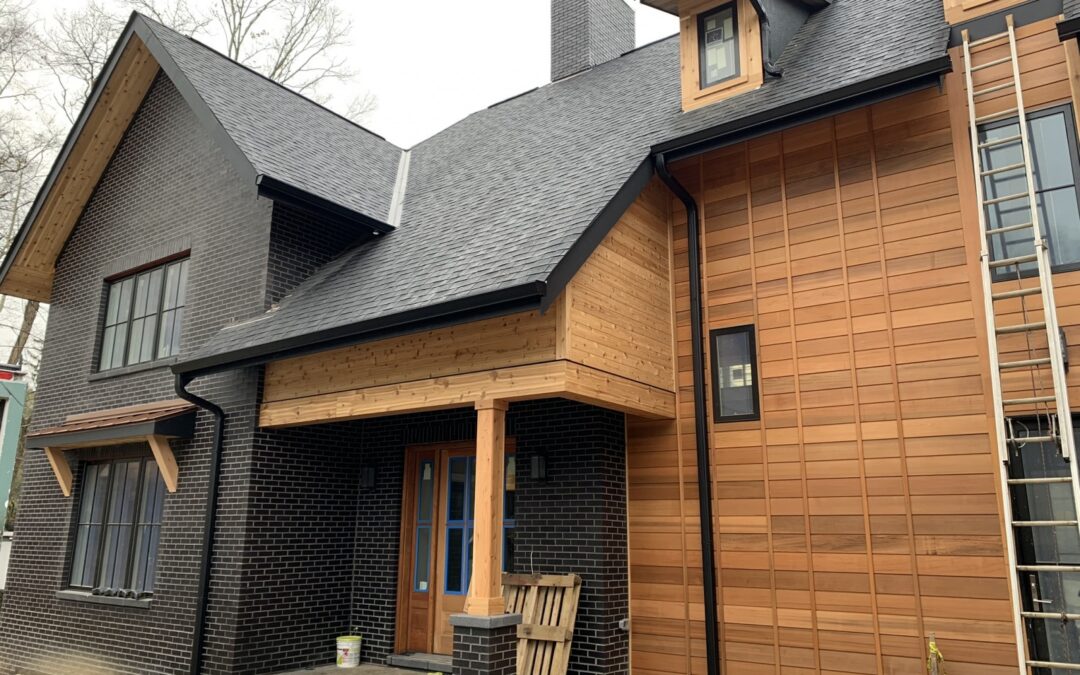The wood soffit is a critical component of your home’s exterior, often overlooked but essential for protecting your property and maintaining its structural integrity. If you’re noticing issues like peeling paint, water damage, or pests in your attic, it may be time to consider repairing or replacing your wood soffit. In this comprehensive guide, Tiger Gutters in Memphis, TN, will walk you through everything you need to know about wood soffit repair and replacement.
What is a Wood Soffit?
The soffit is the flat, horizontal surface that connects your roof overhang to the exterior wall of your home. It provides a neat, finished appearance while also protecting the rafters from weather elements. Wood soffits are a traditional option, often chosen for their natural beauty and compatibility with various architectural styles.
In addition to aesthetics, soffits serve a functional purpose. They provide ventilation to your attic, preventing moisture buildup and maintaining the health of your roofing system. Proper ventilation is essential for regulating temperatures and avoiding issues like mold growth and roof deck rot.
Signs Your Wood Soffit Needs Repair or Replacement
Like any exterior feature, wood soffits are exposed to the elements and can experience wear and tear over time. Some key signs that you might need to repair or replace your wood soffit include:
- Peeling or Flaking Paint: If the paint on your wood soffit is peeling, it’s a sign that moisture has penetrated the wood. This is often the first sign of a problem.
- Rotting Wood: Wood is vulnerable to rot when exposed to excessive moisture. If your soffit feels soft or crumbles to the touch, rot has set in and repair or replacement is necessary.
- Water Stains or Moisture Marks: Stains or discoloration on the soffit indicate water infiltration. Left unchecked, this can lead to structural damage in your attic or roofing system.
- Pest Infestations: Gaps or holes in the soffit can allow insects, rodents, and birds to enter your attic. This can lead to further damage and insulation issues.
- Ventilation Issues: If your attic feels excessively humid or your energy bills are increasing, it may be due to inadequate ventilation. Blocked or damaged soffits can prevent proper airflow, leading to moisture buildup and temperature control problems.
Causes of Wood Soffit Damage
Several factors can contribute to soffit damage over time, particularly in environments like Memphis, TN, where humidity and storms are common. Some of the primary causes of wood soffit deterioration include:
- Water Exposure: Rain and condensation are the biggest threats to wood soffits. Without proper maintenance or sealing, water can seep into the wood, leading to rot and mold growth.
- Improper Installation: Soffits that were not installed correctly can be more prone to damage. Poor installation may result in gaps, weak spots, or insufficient ventilation.
- Pests: Insects like termites or carpenter ants can damage wood soffits by burrowing into the material, weakening its structural integrity.
- Sun Damage: UV rays can cause the wood to dry out, crack, and lose its finish, making it more susceptible to moisture intrusion.
The Wood Soffit Repair Process
When considering wood soffit repair, the process generally involves the following steps:
- Inspection: The first step is to assess the extent of the damage. This involves checking for rot, moisture, pests, and ventilation issues. Any areas that are soft or discolored will need to be addressed.
- Removal of Damaged Sections: Once damaged areas are identified, the next step is to remove the compromised sections of wood. This may involve cutting away rot or replacing entire panels if the damage is extensive.
- Replacement Materials: When replacing sections of the wood soffit, it’s important to use the same type of wood for consistency. The replacement wood is cut to size and primed to ensure it’s ready for installation.
- Reinstallation: After preparing the new sections, they are securely installed in place. This step ensures that the soffit remains properly ventilated and sealed against the elements.
- Painting or Staining: To protect the wood from future damage, it is typically painted or stained after installation. This seals the wood and provides a finished look that blends with the rest of your home’s exterior.
- Ventilation Check: After the repair, it’s essential to verify that the soffit vents are working correctly. Adequate ventilation is crucial to maintaining the overall health of your roof and attic space.
The Benefits of Replacing a Wood Soffit
In some cases, repairs may not be enough to restore a damaged wood soffit, and full replacement may be necessary. Replacing a wood soffit comes with several benefits, including:
- Improved Home Appearance: A new wood soffit enhances the curb appeal of your home. Its clean, fresh look can make a significant difference in the overall appearance of your exterior.
- Better Protection Against Water Damage: By replacing damaged or rotting wood, you can prevent further water infiltration, which can cause severe structural issues.
- Enhanced Ventilation: A properly installed wood soffit provides adequate ventilation, helping regulate the temperature in your attic and reducing the risk of mold growth or damage to your roof.
- Increased Energy Efficiency: Proper attic ventilation helps maintain indoor temperatures, reducing strain on your HVAC system and potentially lowering energy costs.
Alternatives to Wood Soffit
If you’re considering replacing your wood soffit, there are alternatives to wood that may offer longer-lasting protection:
- Vinyl Soffit: Vinyl is a low-maintenance option that resists moisture, insects, and UV rays. It’s available in various colors and finishes, making it easy to match your home’s aesthetic.
- Aluminum Soffit: Aluminum is another durable option that resists rust and corrosion. It’s a lightweight material and offers excellent ventilation.
- Composite Soffit: Made from a combination of wood fibers and plastic, composite soffits offer the appearance of wood with greater resistance to the elements.
Conclusion
Wood soffits play a crucial role in the protection and ventilation of your home. Regular inspection and maintenance are key to preventing damage and extending the life of your soffits. If you notice signs of damage like peeling paint, water stains, or pest activity, it may be time to consider repairing or replacing your wood soffit.
Understanding the repair and replacement process ensures you can make informed decisions about maintaining the exterior of your home. Whether it’s repairing a small section or replacing an entire soffit, addressing these issues promptly helps preserve the integrity of your roof and attic.
At Tiger Gutters in Memphis, TN, we know the importance of protecting your home from the elements, and we hope this guide provides valuable information about wood soffit repair and replacement. For more advice on maintaining your home’s exterior, stay tuned for more educational content!

